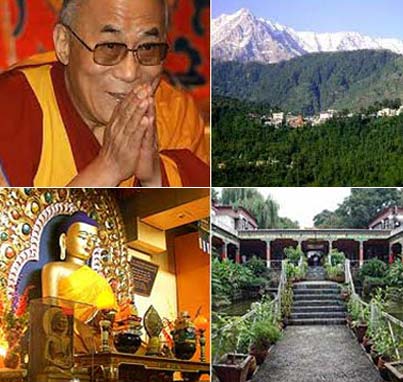
General Information about Dharamshala
Situated 520 kilometers to the northwest of Delhi, bwas once the Headquarters of the British Administration of Kangra, Kullu and Lahul region of Himachal Pradesh before India’s independence. It was then and remains today a well known hill station and a refuge from the heat of the plains. Today, however, Dharamsala is also one of the most important tourist destinations in northern India. It is divided into two separate areas: Lower Dharamsala, where government offices and services are located, and Upper Dharamsala also known as McLeod Ganj which sits atop a ridge 10 km above the main shopping area, Kotwali bazaar.
McLeodganj is the center of the Tibetan community in exile and the residence of His Holiness The Dalai Lama, the Tibetan spiritual leader and head of the Tibetan government in exile.
For trekkers, the Dhauladhar range is a paradise offering mountain passes ranging from 3000 to 5000 meters in height and providing entry to the Chamba valley and the central Himalayan ranges.
For visitors seeking the teachings and spiritual guidance to be found in the numerous Tibetan monasteries and art centers, Dharamsala is a most pleasant and relaxed haven in the Indian Himalayas. The scenic health resorts of Upper Dharamsala are surrounded by dense forests of oak, rhododendron and deodar and offer beautiful walks and panoramic views of mountains above and the valley below. The Dhauladhar’s, meaning white mountains, form the backdrop of the town below which lies the beautiful Kangra valley, bordered by green terraced fields on hill slopes and carpeted with the rice paddies and tea gardens that surround the slate roofed houses of the many villages.
Tourist attractions around Dharamshala
The Dalai Lama’s Temple or Tsuglakhang.
The main Buddhist temple, situated opposite the residence of His Holiness Dalai Lama. It is open from sunrise to sunset each day and is visited by thousands of devotees and tourists. In the center the statue of Lord Budha or Sakyamuni is three meters high and gilded in bronze. To either side are Padmasambhava, Tibet’s great tantric teacher and Avalokiteshwara or Chenrezig, the Budha of Compassion, He who hears the cries of the world, in silver with eleven faces, a thousand arms and one thousand eyes.
Bhagsu Nag Temple
One km from McLeod Ganj is an ancient Hindu temple dedicated to Bhagsu Nag, the snake god, and to Lord Shiva.
St. John’s Church
A ten minute walk below McLeod Ganj, on the road to Lower Dharamsala, is the Anglican Church built by the British in 1852. Surrounded by a heavily wooded pine and deodar forest, the Church maintains a Christian cemetery adjacent to it and is a repository of local history.
The Tibetan Institute of the Performing Arts
TIPA was founded in 1959 by His Holiness the Dalai Lama to preserve traditional Tibetan art forms in music, dance and theatre. The Institute is located a short distance above McLeod Ganj and is a training center for young Tibetan artists.
The Tibetan Library of Works And Archives
TLWA lies within the complex of the Central Tibetan Administration two kilometers below McLeod Ganj. Established in 1971, it houses rare books and current Tibetan literature as well as a small holding of books and journals in English and other languages. In addition, the Library is a teaching center offering courses on Tibetan language arts and Buddhist philosophy and literature to local and foreign students. It is a small publishing house of Tibetan books and journals.
Kangra Art Museum
Located in the centre of Kotwali bazaar in lower Dharamsala. The museum main exhibits are paintings from the Kangra School of Miniature Painting, also sculptures, tribal ornaments and photographs of local monuments.
Norbulingka
Situated in the valley below Dharamsala, Norbulingka is an Institute for the preservation of traditional Tibetan arts and crafts. At present, it houses over 300 teachers, students and workers. The arts and crafts include Thangka painting, tailoring, metal sculpture and wood crafts. There is a popular Losel doll museum and a temple.
Pong Dam Lake
2-3 hours drive from Dharamsala, Himachal’s largest body of fresh water, provides a shelter for 400 species of migratory birds. This birds watcher’s paradise, also offer amazing lake views and excellent swims and water activities.
Other Attractions
In addition to the above, there are several other Buddhist monasteries and institutes worth visiting. Dharamkot and Bhagsu Nag on the periphery of McLeod Ganj are the main villages inhabited by the Gaddi, a shepherd tribe and the original inhabitants of Dhauladhar. The influx of tourism to these villages has prompted the appearance of small guest houses within the villages making possible longer and comfortable visits.
